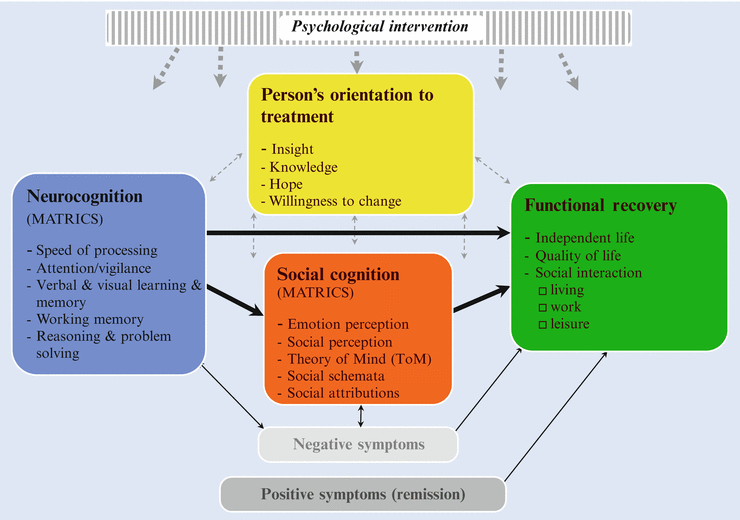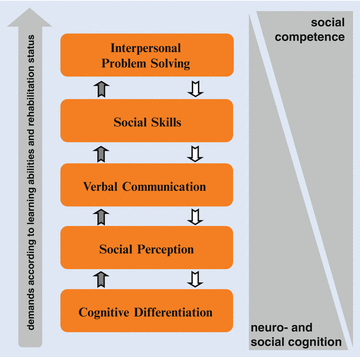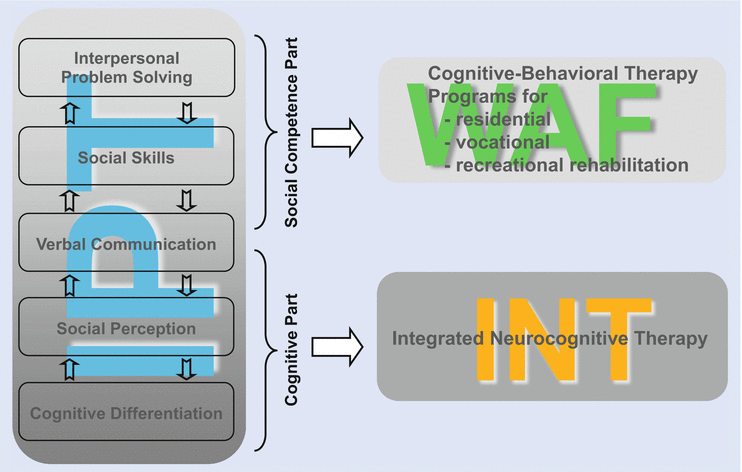Neurocognitive areas
Description
Impairments
Speed of information processing
Speed of the information to be processed
Less information per unit of time
Attention/vigilance
Filtering of information
Selective attention/sustained attention (vigilance)
Lack of filtering and suppression of irrelevant stimuli;
Longer reaction times, increased distractibility, and lack of reaction to target stimuli
Verbal and visual learning and memory
Intake and storage of verbal and nonverbal information
Impaired learning and recall performance;
Relatively intact implicit, procedural memory
Working memory
Verbal, visual, and spatial short-term memory
Lacking maintenance and manipulation of visual-spatial and verbal information
Reasoning and problem solving
Complex strategies for planning and decision-making
Impairments in cognitive flexibility;
Deficits in action planning
Speed of information processing: This area concerns how quickly information is processed and requires both motor and perceptual abilities.
Attention/ vigilance: Selective attention is the ability to select stimuli according to their relevance and to focus on target stimuli while ignoring disturbing stimuli (distractors). On the other hand, vigilance designates the state of maintaining attention over an extended period in situations with a low stimulus frequency.
Verbal and visual learning and memory: These two neurocognitive domains encompass the perception and storage of verbal and nonverbal information. The MATRICS initiative decided on two separate areas for the processing of verbal and visual information because persons with schizophrenia exhibit different impairments in these areas.
Working memory: Working memory has the function of storing verbal and spatial information that is relevant to action. This is constantly adjusted to the current situation, making it possible to control one’s behavior in a planned way.
Reasoning and problem–solving: Together with working memory, this area is summarized by the concept of “executive functions”. These functions include cognitive flexibility, concept formation, and planning and problem-solving abilities. They also include the ability to monitor one’s own actions and to suppress them in favor of new objectives.
The MATRICS initiative first concentrated solely on differentiating neurocognitive areas. Later, the concept of social cognition was developed due to its growing theoretical and practical importance for research and treatment. Social-cognitive processes refer to the processes of information processing upon which social interactions are based. Among these is the ability to interpret the intentions, characteristics, and behaviors of other persons and to react appropriately to them (Brothers 1990; Green et al. 2005, 2008). On the other hand, the area of neurocognition generally includes processes of human information processing (i.e. operations involving the assignment, association, and evaluation of information). These form the basis of human experience and behavior, but relate only to non-social content (Roder et al. 2008). The MATRICS initiative led to the development of a standardized, commercially available battery of tests (MCCB: www.matricsinc.org/MCCB.htm) (Buchanan et al. 2011). So far, it consists of ten measurement tools for recording the six neurocognitive areas and the social-cognitive domains of emotion perception. The MATRICS initiative has further developed the concept of social cognition and currently distinguishes between five social-cognitive areas (Green et al. 2005, 2008; Roder et al. 2010) (Sect. 1.2; Table 1.2):
Table 1.2
Social-cognitive MATRICS areas
Social-cognitive areas | Description | Impairments |
|---|---|---|
Emotion perception | Perception and use of emotions | Slower and less accurate recognition of emotional stimuli; Impaired regulation of emotional reactions |
Social perception | Recognition and evaluation of social roles and rules in interpersonal situations | Impaired recognition of social cues; Deficient processing of contextual information |
Theory of mind (ToM) | Ability to empathize with other people and to infer their intentions | Difficulty understanding false assumptions, deception, irony, metaphors, and cues |
Social schemata | Knowledge representations about social norms and roles | Faulty knowledge representations; Impaired access to and/or implementation of this information |
Social attributions | Causal attribution following experiences of success or failure | Excessive form of internal attribution for positive events; External attribution in the case of failure (“self-serving bias”) |
Emotion processing: This area comprises the perception and utilization of emotions. Emotion perception has often been investigated among patients with schizophrenia, typically with the use of facial expressions.
Social perception: This refers to the ability to understand central features of social situations and interactions.
Theory of mind (ToM): This construct describes the ability mentally to represent the intentions, characteristics, and assumptions of other persons by adopting their perspectives and to make inferences based on these. This is important in order to predict, to explain, or to influence the behavior of others.
Social schemata/social knowledge: Social schemata are knowledge structures in long-term memory. They contain declarative or procedural information about which roles, rules, and goals characterize certain social situations. They are thus crucially involved in the encoding of new information and have an action-guiding function.
Social attribution styles: These include the causal explanations a person generates for particular experiences of success or failure in order to understand social situations and events.
The social-cognitive processes of persons suffering from schizophrenia have been generating increasing interest since the mid-1990s. However, the history of their research began much earlier (Penn et al. 1997, 2006). In the 1950s and 1960s for example, schizophrenia studies were conducted that concerned the influence of experimental and social contexts on test performance (Cromwell and Spaulding 1978), on the perception of emotional images (Buss and Lang 1965) and on social reasoning processes (Gillis 1969). These papers set crucial foundations, yet it was hardly possible to interpret the results, since the researchers lacked operational definitions of the concepts under investigation and suitable assessment instruments. The reason for the renewed interest in the area of social cognition in schizophrenia research appears above all to be its central role in integrative models for the level of psychosocial functioning and for recovery (Fig. 1.1).


Fig. 1.1
Integrative model: possible mediators between cognitions and functional recovery (Roder et al. 2010)
According to this model, the level of psychosocial functioning of a person with schizophrenia is determined by multiple factors: neurocognitive and social-cognitive functions, positive and negative symptoms, and the orientation of the treatment. Cross-sectional and longitudinal empirical studies were able to confirm the relationship postulated in the model between neurocognitive areas and the level of psychosocial functioning (Green et al. 2000, 2004; Milev et al. 2005; Bowie et al. 2006; Cohen et al. 2006; Brekke and Nakagami 2010). The percentage of explained variance of the level of psychosocial functioning ranged between 20 and 40 % (Couture et al. 2006). As a result, 60–80 % of the variance in the level of psychosocial functioning could not be explained by performance differences in the neurocognitive test. This prompted the search for further influential factors and for an answer to the question of how these relationships originate. Social-cognitive functions became a point of central focus because they exhibit consistent associations with neurocognitive areas (Brüne et al. 2007) and are considered to be essential determinants of the level of psychosocial functioning (Couture et al. 2006; Fett et al. 2011). Although neurocognition and social cognition are interconnected constructs, there is empirical evidence that they are not redundant:
The correlations are only of average magnitude (Wykes and Reeder 2005).
A neural network appears to exist that is specialized in the processing of social information (Brunet-Gouet and Decety 2006; Pinkham et al. 2008).
Differential impairments in neurocognitive or social-cognitive functions are possible (Pinkham et al. 2003).
Current studies have found evidence that the correlation between basal neurocognitive functions and the level of psychosocial functioning in patients with schizophrenia is mediated by social-cognitive functions. In other words, social-cognitive functions act as a mediator variable in this correlation (Schmidt et al. 2011). The area of negative symptoms is being discussed as a further mediator variable (Ventura et al. 2009; Couture et al. 2011; Rassovsky et al. 2011). In studies, at least moderate correlations were found between neurocognitive and social-cognitive areas and that of negative symptoms. The question of causality remains unexplained to this day, but study results suggest that cognitive impairments are more the cause than the effect of negative symptoms (Bowie and Harvey 2005; Kirkpatrick et al. 2006; Sergi et al. 2007). In longitudinal studies, changes in negative symptoms proved to be relatively independent of cognitive changes and yielded differential correlations with the level of psychosocial functioning, which also speaks for a separation of these areas (Bowie et al. 2010; Foussias and Remington 2010). The extent of positive symptoms on the other hand had fewer correlations with cognitive functions and the level of psychosocial functioning than did the negative symptoms. However, some parameters do appear to fluctuate with acute psychotic episodes. During remission, these parameters seem also to be associated with an improvement of function recovery (Wykes and van der Gaag 2001; Bertrand et al. 2007; Ventura et al. 2010).
The recovery concept also stresses the significance of the patient’s individual treatment orientation for therapy responsiveness . This includes the patient’s insight into his or her problems as well as knowledge of the disorder and how to cope with it. Other influential factors that appear to be especially decisive for therapeutic success include motivation (Medalia and Lim 2004; Velligan et al. 2006; Gard et al. 2009; Choi and Medalia 2010), empowerment/self-efficacy as well as hope and knowledge (Resnick et al. 2005; Sibitz et al. 2011).
This integrative model (Fig. 1.1) makes it clear that approaches to psychological therapy from each of these areas can apply neurocognitive and social-cognitive remediation therapy, cognitive-behavioral therapy for the treatment of persisting positive symptoms , therapy of social competencies or psychoeducation, and family therapy (Roder et al. 2010). Because of the great number of factors influencing the level of psychosocial functioning, integrative approaches that embed cognitive and social factors into a multimodal therapeutic concept appear to be especially promising. Therefore, our definition of an integrative neurocognitive approach encompasses two aspects: An intervention is integrative if, in addition to neurocognitive functions, at least one of the following areas is therapeutically impacted: social cognition, knowledge about the illness/difficulties/resources, social skills in the residential, vocational, and recreational domains, and cognitive thought patterns (e.g. irrational beliefs). Moreover, the term “integrative” makes it clear that therapy should always be based on a multimodal treatment concept, individual rehabilitation goals, and the cognitive resources and weaknesses of each participant.
1.3 Further Developments of Integrated Psychological Therapy (IPT): INT and WAF
One example of such an integrated neurocognitive therapy program is Integrated Psychological Therapy (IPT ) (Roder et al. 1988, 2008, 2010). It combines neurocognitive and social-cognitive remediation therapy with the therapy of social competencies and interpersonal problem-solving abilities. IPT is divided into five modules of increasing complexity which build upon each other (Fig. 1.2): In the first module, “Cognitive Differentiation”, various neurocognitive functions should be improved (e.g. attention, verbal memory, cognitive flexibility, concept-formation). The second module, “Social Perception”, addresses operations of social-cognitive information processing such as social and emotional perception. The link between the first two cognitively oriented modules and the last two, more behavior-oriented modules is established by the third module, “Verbal Communication”. It aims at improving verbal fluency and executive functions, which are necessary for interpersonal relationships. In the last two modules, “Social Skills” and “Interpersonal Problem Solving”, role play and group problem-solving exercises promote the acquisition of social skills. The group is led by one therapist and one co-therapist and comprises five to eight participants. It is best carried out twice a week for 60 min over a period of at least 3 months. Additional homework assignments, in vivo exercises, and individual therapy supplement these group sessions.
IPT has been evaluated in 36 independently published studies in 12 countries in Europe, America and Asia (Roder et al. 2006, 2011). The manual is now obtainable in 13 languages. The summarization of these individual study results in meta-analytic techniques speaks for the effectiveness of IPT in comparison to placebo-attention or empty control groups in the area of neurocognition and social cognition, negative symptomatology, and the level of psychosocial functioning. These effects also remained unchanged after a follow-up period (Roder et al. 2006, 2010). IPT thus represents one of the first systematic, manual-based cognitive approaches to group therapy for people suffering from schizophrenia. IPT was initially conceived over 30 years ago (Brenner et al. 1980). IPT’s conception thus anticipated the growing importance of social cognition and an integrative approach to treatment. On the basis of the IPT approach, two further developments arose against the backdrop of the new state of empirical and theoretical knowledge described above (Fig. 1.3).
As an initial step, our team expanded the two IPT modules “social skills” and “interpersonal problem solving” by developing specific group therapy programs for social competencies in the residential, vocational, and recreational domains (abbreviated WAF, from the German “Wohnen, Arbeit, Freizeit”) (Roder et al. 2008). WAF has the aim of sensitizing participants’ perceptions of their own needs in these areas of everyday life. Building upon this, it strives to support the formation of goals for specific residential, vocational, or recreational situations. In order to help implement patients’ decisions, the group rehearses necessary social competencies and activates both potential difficulties and existing resources. WAF too has been evaluated in effectiveness studies. These showed, in conformity with the recovery perspective, that the therapy’s concern with everyday life contributed to an increase in patient motivation. This is a decisive prerequisite for improving social competencies and reducing negative symptoms (Mueller and Roder 2005; Roder et al. 2006).
Integrated Neurocognitive Therapy (INT) represents a further step in this development. IPT also had an influence on INT’s treatment approach and therapeutic methods. INT encompasses all 11 of the neurocognitive and social-cognitive MATRICS areas and thus expands on the first two IPT modules. The combined treatment of neurocognitive and social-cognitive functions are also based on the results of IPT research: Implementation of all five IPT modules resulted, with the same therapy duration, in greater and longer-lasting effects compared with individual neurocognitive modules (Roder et al. 2006, 2010; Mueller et al. 2007). IPT focuses initially on basal neurocognitive functions before moving increasingly to social-cognitive processes and finally to complex interpersonal skills. This didactic structure makes it possible for the participants to become accustomed to the group context quickly. They can also have a sense of achievement already at the beginning of the therapy process thanks to clearly structured tasks which are not emotionally stressful. Improvement of basal neurocognitive functions appears to be a necessary requirement for the rehabilitation of social-cognitive functions and social skills, since they are seen to be limiting factors for therapy success. Accordingly, the therapeutic content of INT is also organized into sequential modules. In the process of therapy, the degree of emotional activation and the complexity of the exercises grow with time while being increasingly less structured by the therapists. Consistent with IPT, INT was also conceived as a cognitive-behavioral approach to group therapy. The reason for this is that, in this setting, group processes arise that are relevant to everyday life but nonetheless provide safe conditions, thus easing the learning of social skills (Mueller et al. 2011).
Given the theoretical background outlined here and the current state of empirical knowledge, an integrative and well-coordinated treatment and rehabilitation of patients with schizophrenia from the standpoints of both functional and subjective recovery remains an important future goal. Studies have showed that medicinal treatment with typical and atypical neuroleptics yield few positive effects on the level of cognitive functioning, with moderate effects on negative symptoms and the level of psychosocial functioning (Bowie and Harvey 2005; Harvey et al. 2007; Keefe et al. 2007, 2011). Accordingly, the importance of multidimensional, integrative approaches to psychological treatment, focusing on the cognitive and social impairments brought on by the illness, will increase considerably in the years ahead.









